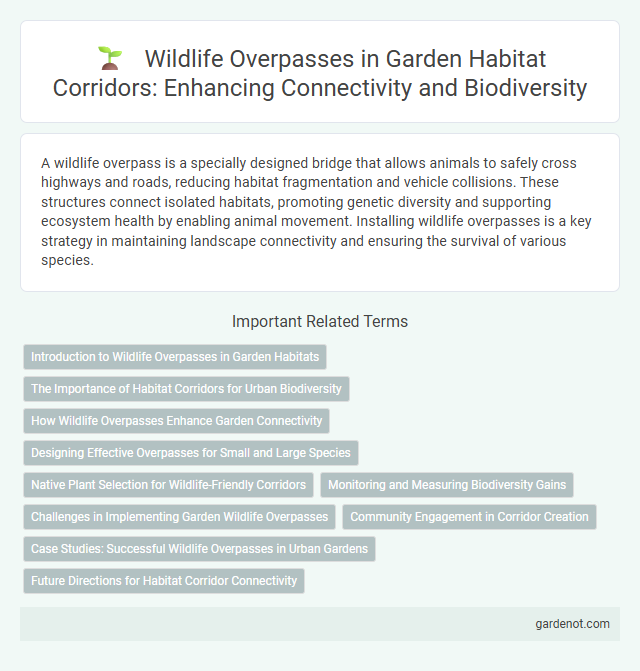A wildlife overpass is a specially designed bridge that allows animals to safely cross highways and roads, reducing habitat fragmentation and vehicle collisions. These structures connect isolated habitats, promoting genetic diversity and supporting ecosystem health by enabling animal movement. Installing wildlife overpasses is a key strategy in maintaining landscape connectivity and ensuring the survival of various species.
Introduction to Wildlife Overpasses in Garden Habitats
Wildlife overpasses in garden habitats serve as crucial connectors that enable safe animal movement across urban barriers such as roads and highways. These structures reduce habitat fragmentation by linking isolated green spaces, promoting biodiversity and genetic exchange among wildlife populations. Designed with native vegetation and natural substrates, wildlife overpasses integrate seamlessly into garden habitats, supporting species ranging from small mammals to larger fauna.
The Importance of Habitat Corridors for Urban Biodiversity
Habitat corridors, such as wildlife overpasses, play a crucial role in maintaining urban biodiversity by connecting fragmented ecosystems and allowing safe passage for animals across busy roadways. These structures reduce roadkill incidents and promote gene flow among isolated populations, enhancing species survival and ecological resilience. Integrating wildlife overpasses into urban planning supports sustainable habitats and helps preserve diverse wildlife communities in rapidly developing areas.
How Wildlife Overpasses Enhance Garden Connectivity
Wildlife overpasses significantly enhance garden connectivity by providing safe passageways for animals, reducing habitat fragmentation and facilitating gene flow among isolated populations. These green corridors enable the movement of diverse species across urban or suburban landscapes, supporting biodiversity and ecosystem resilience. By linking fragmented garden habitats, overpasses promote ecological interactions and contribute to the long-term health of local wildlife communities.
Designing Effective Overpasses for Small and Large Species
Wildlife overpasses must be designed with species-specific requirements, incorporating varying widths, vegetation types, and noise barriers to accommodate both small and large animals. Structural features such as gentle slopes and natural substrates enhance accessibility for small mammals, reptiles, and amphibians, while broader spans and natural cover support large mammals like deer and bears. Integrating multispecies corridors with adaptive monitoring ensures functional connectivity and reduces wildlife-vehicle collisions across diverse habitats.
Native Plant Selection for Wildlife-Friendly Corridors
Native plant selection for wildlife overpasses enhances habitat corridors by providing essential food, shelter, and breeding grounds for local species. Incorporating diverse native grasses, shrubs, and flowering plants supports pollinators and small mammals, promoting ecological connectivity. Selecting region-specific flora reduces maintenance needs and increases the overpass's effectiveness in facilitating safe wildlife movement.
Monitoring and Measuring Biodiversity Gains
Wildlife overpasses play a crucial role in maintaining habitat corridors by facilitating safe animal crossings and reducing road mortality. Monitoring efforts often utilize camera traps, GPS tracking, and genetic analysis to assess species diversity and population connectivity on both sides of the overpass. Measuring biodiversity gains involves analyzing changes in species richness, abundance, and movement patterns to evaluate the effectiveness of the overpass in restoring ecological networks.
Challenges in Implementing Garden Wildlife Overpasses
Wildlife overpasses face significant challenges such as high construction costs, land acquisition difficulties, and engineering complexities to accommodate diverse species and ensure safety. Vegetation design must mimic natural habitats to encourage animal use while minimizing human disturbance and invasive species. Monitoring effectiveness and maintaining connectivity amid increasing urban development remain critical for successful garden wildlife overpass implementation.
Community Engagement in Corridor Creation
Wildlife overpasses serve as critical habitat corridors that reconnect fragmented landscapes, enabling safe animal movement across roads and highways. Community engagement plays a vital role in the successful design and implementation of these structures, fostering local support and incorporating indigenous knowledge. Collaborative efforts between government agencies, conservation groups, and residents enhance corridor effectiveness and biodiversity conservation.
Case Studies: Successful Wildlife Overpasses in Urban Gardens
Wildlife overpasses in urban gardens, such as the Capilano Wildlife Corridor in Vancouver and the Montreux Green Roof Project in Switzerland, demonstrate significant success in reconnecting fragmented habitats and facilitating safe animal movement. These case studies reveal increased biodiversity and reduced roadkill incidents by providing vegetated pathways over busy roads, integrating natural elements into urban landscapes. Monitoring data emphasizes their role in supporting species like deer, foxes, and small mammals, confirming the effectiveness of green infrastructure in urban conservation efforts.
Future Directions for Habitat Corridor Connectivity
Wildlife overpasses represent a critical advancement in habitat corridor connectivity, enabling safe animal movement across fragmented landscapes and reducing roadkill incidents. Future directions emphasize integrating smart technology such as sensor-based monitoring to optimize crossing usage and guide adaptive management. Expanding overpass networks to connect isolated habitats supports biodiversity conservation and resilience against climate change-induced habitat shifts.
Wildlife overpass Infographic

 gardenot.com
gardenot.com